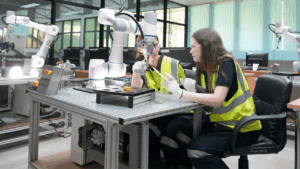Global food supplies are currently facing a huge challenge. As the global population rises, so too does the need for food. With a global population expected to reach 9.7 billion by 2050, according to the UN, there’s a need to increase food production by 70% in the next 30 years to ensure enough food for everyone and avoid further food insecurity.
Food insecurity is becoming more recognized as a global issue that affects an estimated 750 million people.
In addition to this, the agricultural industry can have its own environmental impact.
Some problematic areas that are primed for improvement include greenhouse gases (GHGs) from food waste decomposition, the effects of fertilizer and pesticide use on wildlife and surrounding areas, the eutrophication (growth of algae in water sources leading to the eventual die-off of all fish and plants) and monoculture agriculture (where one crop is grown on the land at a time) which can lead to land degradation making the land unsuitable for further farming.
In this article on sustainable agriculture as part of our sustainability series, we’re looking at what is sustainable agriculture, the current problems with agriculture and what we can do to improve and provide some solutions in the form of Agroecology and Agtech.
What is sustainable agriculture?
As we’ve seen in our “What is Sustainability” blog, sustainability has three parts to it: society, economy and environmental stewardship. Therefore, sustainable agriculture must address these three areas to be truly considered sustainable.
While studies show that agriculture is more successful in raising the income of those in poverty compared to other sectors, some argue that farmers in poverty can feel forced to mine natural resources including soil fertility to make ends meet which has the potential to hurt their livelihoods in the future. This is the opposite of sustainability since it prevents future generations from farming on that land.
To be considered sustainable, agriculture needs to integrate social, environmental, and economic interests. The goals of sustainable agriculture are; to help provide enough food for everyone, bring communities out of poverty and provide an enhanced quality of life for farming families, and utilize farming methods that promote soil health and reduce reliance on fossil fuels for environmental sustainability.
Why do we need sustainable agriculture?
Many of the issues with the current agricultural industry are environmental. However, if not addressed, these issues can spill over into the economic and social domains which we’ll explore here.
Environmental issues
Agriculture often places significant pressures on natural resources and the surrounding environment. Most of these issues stem from the use of fertilizers and pesticides which are deemed necessary to grow as much as possible in a given space. In the long term, fertilizer can actually contribute to a reduction in the fertility of the land, damage soils and water sources and contribute to GHG emissions.
While fertilizers and pesticides help to put nutrients needed for plant growth into the soil and limit the pests damaging crops thereby improving efficiency in the short term, they can cause issues in the long term.
Fertilizer run-off can enter nearby water sources in cases where an excessive amount has been used or where rain transports it into other water sources. This pollutes the water sources and, in the most serious cases, leads to eutrophication where fish and aquatic plants die due to the overgrowth of algae caused by the fertilizer in the water. Pesticides too can harm wildlife – the plight of pollinators, such as bees, is well known.
In addition, the production of fertilizers involves heavy fossil fuel use. The extraction and mining of nitrogen and phosphorus, the main ingredients in many fertilizers, are energy-intensive processes and these processes often rely on fossil fuel energy.
Another issue with contemporary farming methods is that they generally rely upon a few primary crops. Sustainable crop production moves away from this monoculture method of farming which can make crops more vulnerable to disease and pests. Crop rotation and even combining different crops in the same field can reduce the need for fertilizer and pesticides compared to monoculture farming. Further, monoculture farming draws on the same nutrients from the soil which can lead to nutrient depletion in the soil which translates to a dependence on more fertilizer to grow plants. The FAO estimates there may be as few as 60 harvests left.
Social and economic issues
The World Bank states that agricultural development is “one of the most powerful tools to end extreme poverty”, and they found that “growth in the agricultural sector is two to four times more effective in raising incomes amongst the poorest communities compared to other economic sectors.”
This sounds promising.
However, when considering the environmental issues discussed above, it’s clear the current methods of agriculture cannot be sustained; causing problems for the economy, farming communities in the future and society as a whole if we cannot produce sufficient food.
There are already concerns about our ability to produce sufficient food especially given that the global population is set to increase.
How can agriculture become more sustainable?
In recent years steps have been made to move towards more sustainable farming methods. Some of the features of sustainable agriculture may surprise you. While they’re becoming more popular, there is still a lot to be done.
Introduce more sustainable farming methods
There are many sustainable farming techniques we can employ to make farming more sustainable. One of the big ways to achieve agricultural sustainability is to reduce our global reliance on pesticides and fertilizers and focus on natural processes that can be introduced to limit pest populations.
An example of one of the components of sustainable agriculture is planting hedgerows along field edges. This encourages pest predators such as birds and other animals into the area and keeps the number of pests in check, reducing the need for pesticides.
Crop rotation, or planting cover crops, helps to improve soil fertility as different plants draw from, and give back, different nutrients to the soil. These farming methods are crucial in sustainable farming systems and farmers invested in long-term sustainability “often prioritize caring for the soil because they recognize that a healthy soil promotes healthy crops and livestock”. This reduces the need for fertilizers and helps eliminate pests that target specific crops thus reducing the need for pesticides too.
You may hear sustainable farming methods referred to as Agroecology. Agroecology is the name given to farming techniques that minimize the environmental impact of farming.
One of these methods is organic farming. However, achieving certified organic status can be a lengthy and expensive process that is simply not achievable for all farms. Agroecology, therefore, could be the middle path as it encompasses organic farming methods without the certification and inspection process.
Embrace traditional farming techniques
Many of the above are traditional farming methods. Embracing traditional, local farming knowledge and Traditional Ecological Knowledge passed down through generations among Indigenous communities is key to improving the sustainability of the agriculture sector.
Given the changing and locally-specific nature of agriculture, a diverse and adaptive knowledge base is needed and taking advice from those who know the land is vital for success.
The rise of agtech
Agtech is a section of the cleantech economy that we define as “any technological process, product or service that aims to use fewer materials and/or energy, generate less waste, and cause less negative environmental impact than current standards” in our Cleantech report.
Agtech refers to agricultural practices which are more efficient, safe and less environmentally damaging than current agricultural methods. In this way, Agtech represents a move to more sustainable agriculture by reducing the industry’s impact on the environment and making the work safer for people. There are also economic benefits as the increased efficiency helps save farmers money in the long run.
You can read more about sustainable agriculture in Canada and Canadian Agtech in our “Canadian Cleantech in Action: Agriculture” blog.
Summary
Agriculture and sustainability can co-exist, and a move towards a more sustainable agriculture industry will be key to food security for the long term. Reducing the use of chemical fertilizers and pesticides will help protect both soil and water sources and the rise of Agtech, combined with traditional, local knowledge, could help increase yield in a less damaging way.





